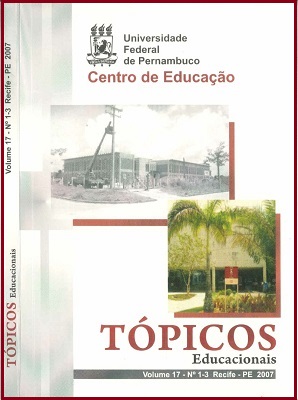CONHECIMENTO, A PEDRA ANGULAR DO DESIGN DE TEL
Palavras-chave:
Epistemologia, Inteligência artificial, Transposição informática, Modelização de conhecimentos, Modelização do aluno, Interação pessoa-sistema, "technology enhanced learning" (TEL)Resumo
Esse texto apresenta o argumento que conhecimento é a pedra angular do design de sistemas TEL. Numa primeira parte, apresentamos o que conhecimento significa na nossa abordagem, e introduzimos a noção de concepção. Depois, exploramos até onde a problemática da validação é central em nossa pesquisa. Para concluir, introduzimos uma caracterização de concepção que pode ajudar a abordar o problema do desenvolvimento de sistema TEL num nível teórico.
Referências
BALACHEFF, N. La transposition informatique. ln: ARTIGUE et al.
(eds.). 20 ans de didtzctique des mathématiques en France. Grenoble: La
Pensée Sauvage, 1993.
BALACHEFF, N. Cours de DEA EIAH, Grenoble 1999-2000.
Disponível em www.didactique.imag.fr/CoursEIAH/index.html,
1999.
BALACHEFF, N.; SUTHERLAND, R. Epistemological domain of
validity of microworlds, the case of Logo and Cabri-géometre. ln:
LEWIS, R. et al. (eds.). Lessons from learning. Arnsterdam: NorthHolland/Elsevier,
1994, p.137-150.
BELLEMAIN, F. A transposição informática na engenharia de
softwares educativos. l SIPEM, 22 a 25 de novembro, Serra Negra
(SP), 2000.
BELLEMAIN, F. Geometria dinâmica: diferentes implementações,
papel da manipulação direta e usos na aprendizagem. 15º Simpósio
Nacional de Geometria Descritiva e Desenho Técnico e IV
Intemational Conference on Graphics Engineering for Arts and
Design, 5-9 Novembro de 2001, São Paulo, Brasil, 2001.
BROUSSEAU, G. Fondements et méthodes de la didactique des
mathématiques, Recherches en didactique des mathématiques, 1986, 7.2, p.
33-115.
CHEV ALLARD, Y. La transposition didactique. Grenoble: Editions La
Pensée Sauvage, 1985.
JACKIW, N. Geometer Sketchpad. Key Curriculum Press,
NICAUd, Jean-François; XUAN, Anh Nguyen; SAIDI, Mustapha;
AUBERTIN, Christian; WACH, Patrice. APLUSIX: a leaming
environment for acquiring problem solving abilities. Source
Proceedings of the third COGNITIVA symposium at the crossroads
lôp. Educ., Reufi:-, 1•. 17, 11"' 1-3, p. 31-.'19. 2007
Conhecimento, a pedra angular do design de TEL 59
of artificial intelligence, cognitive science, and neuroscience table of
contents, Madrid, Spain, Arnsterdarn, The Netherlands: Publisher
North-Holland Publishing Co, 1991, p. 85- 92.
RABARDEL, P. Les hommes et les technologies, approche cognitive des
instrurnents conternporains. Paris: Armand Colin, 1995.
ROSSETII-FERREIRA, M. C.; AMORIM, K. S.; SILVA, A. P. S.;
CARVALHO, A. M. A. (orgs). Rede de significações e o estudo do
desenvolvimento humano. Porto Alegre: ArtMed, 2004.
SELF, J. Theoretical Foundations for Intelligent Tutoring Systerns.
fournal of Artificial Intelligence in Education, 1990. 1(4) 3-14.
SLEEMAN, D. PIXIE: A shell for developing intelligent tutoring
systerns. ln: LA WLER, R.; Y AZDANI, M. (Eds.). Artificial lntelligence
in Education. New Jersey: Ablex, 1987.
SOURY-LA VERGNE, S. (ed.). Baghera Assessment Project, designing
an hybrid and emergent educational society. Les Cahiers du laboratoire
Leibniz, 81, 2003.
TIBERGHIEN, A. Analysis of Interfaces from the Points of View of
Epistemology and Didactics. ln: TIBERGHIEN, A. et al. (eds.).
Intelligent Learning Environments and Knowledge Acquisition in Physics.
Berlin: Springer-Verlag, 1992. p. 181-203.
VERGNAUD, G. Conceptual fields, Problern-Solving and lntelligent
Computer Tools. ln: DE CORTE, E. et al. (eds.). Computer Based
Learning Environments and Problem-Solving. Berlin: Springer-Verlag,
1992. p. 287-308.
Tóp. Educ.. Recife. v 1
Downloads
Publicado
Edição
Seção
Licença
Copyright (c) 2017 Tópicos Educacionais

Este trabalho está licenciado sob uma licença Creative Commons Attribution 4.0 International License.
Autores que publicam nesta revista concordam com os seguintes termos:
a) Os autores mantêm os direitos autorais e concedem à revista o direito de primeira publicação, com o trabalho simultaneamente licenciado sob a licença Creative Commons: creativecommons.org/licenses/by/4.0. que permite o compartilhamento do trabalho com reconhecimento da sua autoria e publicação inicial nesta revista.
b) Esta revista proporciona acesso público a todo o seu conteúdo, uma vez que isso permite uma maior visibilidade e alcance dos artigos e resenhas publicados. Para maiores informações sobre esta abordagem, visite Public Knowledge Project, projeto que desenvolveu este sistema para melhorar a qualidade acadêmica e pública da pesquisa, distribuindo o OJS assim como outros softwares de apoio ao sistema de publicação de acesso público a fontes acadêmicas. Os nomes e endereços de e-mail neste site serão usados exclusivamente para os propósitos da revista, não estando disponíveis para outros fins.









